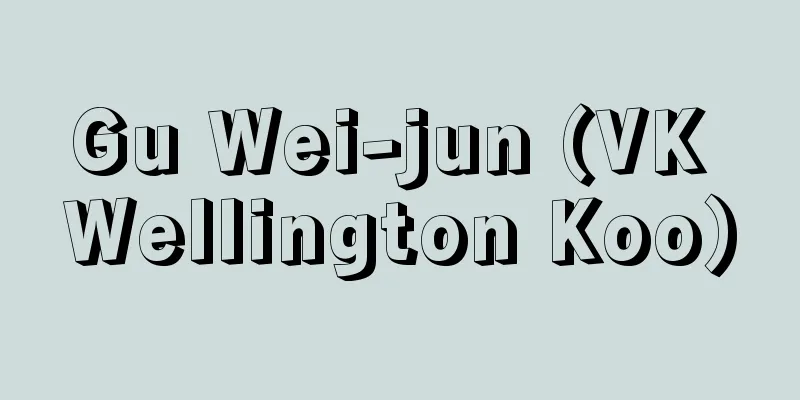Robot - Robot (English spelling)

|
The word "robot" was coined in the 20th century. As we will see later, it first appeared in the Czech writer Karel Capek's play R.U.R. - Rossum's Universal Robot Company (1920). In many dictionaries, the word robot is explained with explanations such as "in the past, it was an automaton or an artificial human." This is due to the history of the word's origins, but today, when people say "robot," they are more likely to mean an industrial robot or a pet robot than an automaton. [Akira Suzumebe] Prehistory of RobotsThe word robot was coined in 1920, but human beings have had the desire to create tools and devices that can act and operate on behalf of humans for much longer than that. Heron (who lived in the 1st to 2nd century) of Alexandria, Greece, noticed that fires were often lit in front of temple altars, and devised a mechanism similar to today's automatic doors, where the doors would open automatically when the fire was burning brightly and close automatically when the fire died down. He also devised a vending machine-like device that dispensed "holy water" when a coin was tossed into a designated spot. In the 18th century, the Frenchman Vaucanson attempted to recreate a mechanism that had the same functions as a duck. He created an artificial duck that not only looked and felt like a duck, but could also bathe, eat, chirp, and defecate. Many other engineers and inventors have also created a variety of other things, including dolls that could write, paint, and play trumpets. In Japan, automata have been made for a long time. One well-known example is the tea-serving doll from the Edo period. When a teacup is placed on the doll's hand, the doll starts moving, and travels to the person who is to serve the tea. When the person takes the teacup, the doll stops. When the person places the teacup on the doll's hand again, the doll turns around and returns to its original position. The doll's power source is a spring made from whale baleen, and the power is transmitted through wooden shafts and gears. There is also a "dangegaeri doll" that performs somersaults while descending steps. This is a mechanism that moves the mercury built into the body of the doll by moving it up and down. These Japanese automata, including their structure, are described in books such as "Karakurizui" and "Karakurikinmou Kagamigusa." These kinds of automata and devices were made as a pastime for engineers, or were effective as decorative tools or tools to amaze people, but they were not mechanisms for industrial use that were directly useful in production. However, not all of the people who invented and made these automata and devices made them their only occupation. For example, Vaucanson made a loom that could weave patterns. However, it is unclear to what extent the technology behind making automata and other devices influenced the making of that loom. In the 20th century, automata became more sophisticated with the advancement of science and technology. They were qualitatively completely different from today's robots, but they combined mechanical and electrical technology (different from today's mechatronics). For example, at the 1927 World's Fair held in New York, a robot called "Telebox" designed by Wensley, an engineer at the Westinghouse Corporation in the United States, was exhibited. It was a square metal doll that could not move, but it had a transmitter and receiver inside, which allowed it to respond to incoming calls to a certain extent. At the 1934 World's Fair held in San Francisco and New York, Westinghouse exhibited a robot called "Wheelie" that could walk, talk, wink, and distinguish colors. Although these robots tried to somehow reproduce human functions, their movements were limited and they were not yet at a stage where they could be used practically. [Akira Suzumebe] The foundation of today's robotsToday's robots would be unthinkable without the development of computers and control engineering. Computers were actively researched during World War II to improve the accuracy of anti-aircraft guns, and control technology became more advanced as radar and atomic bombs were developed. These studies led to the emergence of cybernetics, which mathematically describes the behavior of systems including feedback, or reactions and reflexes. Furthermore, with the development of wireless communication technology during the war, the performance of vacuum tubes also improved dramatically. In a sense, these formed the foundation of today's robotics. However, at the stage of computers using vacuum tubes, it was impossible to create modern robots. Robots are required not only to be able to repeat a single task, but also to be able to easily change the program of the work cycle, in the case of industrial robots. In other words, it is necessary to install a computer on each robot (machine) and control each one individually. The brain of a robot is the computer, and the level of computer technology has a great influence on robot technology. For the above reasons, modern robots were impossible to create at the level of computers using vacuum tubes. Looking briefly back at Japanese computer technology, a computer was made using vacuum tubes in 1956 (Showa 31). It used 1,700 vacuum tubes, but there were limitations to its computing power and speed. Not only was there limited space for the vacuum tubes, but the temperature of the tubes rose, causing instability and reducing the reliability of the data. If these problems of scale and unstable elements could not be solved, it would never have been at a level that could be used as the brain of a robot. The first step to overcome the weaknesses of vacuum tubes was the appearance of transistors and diodes. Transistors can replace the functions of vacuum tubes and do not generate heat. They are much smaller and more reliable than vacuum tubes. From 1959 to 1960, Japanese manufacturers successfully developed computers using transistors and diodes. The next step after transistors was the development of integrated circuits (ICs). Integrated circuits are made by integrating multiple transistors onto a single substrate (substrates are called chips). This led to the advancement of miniaturization and, although it was difficult to design, reduced problems such as poor contact and other negative factors, and improved reliability. The first calculator was produced in Japan in 1964, used 4,000 transistors, and weighed 25 kilograms, but the first IC calculator developed three years later in 1967 was lighter than 4 kilograms. Thus, the arrival of the IC era began to be heralded. The density of chips continued to increase, and in the mid-1970s, ICs with the capabilities of more than 1,000 transistors on a single IC substrate were developed, and these came to be called LSIs (large-scale integrated circuits). In the 1980s, chips with the capabilities of more than hundreds of thousands of elements were developed, and these were named VLSIs (very large-scale integrated circuits). Research into increasing the density of chips has continued into the 21st century, and it is now possible to integrate more than a billion circuit elements. In this way, the increased integration of chips has dramatically improved the computing speed of computers and has also made it possible to make them smaller. These various developments have had a major impact on robotics technology, and as a result, devices with functions equivalent to the human five senses of "seeing, hearing, touching, smelling, and tasting," in other words, sensor functions, have come to play a major role in robotics technology. Thus, robots were put to practical use, and their first active role was as industrial robots. [Akira Suzumebe] Functional classification of industrial robotsRegarding industrial robots, the JIS (Japanese Industrial Standards) classifies them into six types and provides certain definitions. (1) Manual manipulator: A manipulator operated by a human. A manipulator is a device that has functions similar to those of the human upper limbs and moves objects through space. In other words, it can perform tasks such as lifting, reaching, grasping, turning, and flipping. Since it is a manual device, it is assumed that it will be operated by a human. Examples include the Magic Hand that handles radioactive materials through a thick wall, and the arms of deep-sea research vessels. (2) Fixed-sequence robots are manipulators that proceed sequentially through each step of their operation according to preset sequences, conditions, and positions, and the settings cannot be easily changed. "Sequence" means "order," and "fixed sequence" means that the work cycle program cannot be easily changed. They are used when it is necessary to have the robot perform only certain tasks. (3) Variable sequence robots: Unlike fixed sequence robots, variable sequence robots have easily changeable settings. In other words, they are used when the work program can be easily changed and flexibility is required for the work. (4) Playback Robot: A robot with a manipulator that can memorize the sequence, position and other information of a task beforehand by a human being who moves the manipulator and teaches it, and can then read it out as needed to perform the task. In other words, a human being holds the wrist of the robot and moves it, causing the motion to be stored in elements, etc., and then plays it back to make it work. Teaching a motion is called teaching, and is used in welding robots, painting robots, etc. (5) Numerical Control Robot: A robot with a manipulator that can perform tasks according to numerical commands such as sequence, position, and other information. Each operation is quantified and stored in a memory device, and the data is then played back to perform the operation. It is used in precision machining, etc. (6) Intelligent Robot: A robot that can decide its actions based on its sensory and recognition functions. In other words, it is a robot that has sensors, recognizes the object of its work using those sensors, determines what work it should do, and controls itself accordingly. It is often used for inspection, measurement, assembly, etc. Industrial robots are classified as such in Japan, but there is no universal definition worldwide. In some countries, robots that only perform simple repetitive movements are not considered robots. [Akira Suzumebe] Classification of industrial robots based on their movementsIn the case of industrial robots, if we look only at the working parts, we can classify them based on the way their arms move. (1) Cartesian coordinate robots: These robots have arms that can move in straight lines up and down, forward and backward, and left and right. They are used for tasks such as inserting parts vertically and horizontally and punching plastic molds. (2) Cylindrical Coordinate Robot: This has almost the same structure as the Cartesian Coordinate Robot, but instead of moving back and forth, the entire arm can rotate around a pillar. This is suitable for inserting parts vertically and horizontally, and has the added feature of being able to move the arm in a circular motion around the pillar. (3) Polar coordinate robots Instead of the up and down movement of cylindrical coordinate robots, these robots have arms that swing up and down using their base as a fulcrum. They are capable of complex movements and can even move their arms under objects, making them highly valued in automobile factories for use as welding robots. (4) Articulated Robots Just as a human arm has joints, the shoulders, elbows, and wrists of a robot can also rotate. By controlling the movement of each joint, the arm can be moved along curved surfaces and can be brought to the back or underside of the work object to perform work. These robots are often used in automobile painting work. The arms are formed with axes that allow them to rotate and extend and contract freely, and the number of axes that can move is called the "degrees of freedom." If the axis can only move in one direction, it is said to have one degree of freedom. [Akira Suzumebe] Robots in the factoryLet's take a look at how robots are used in factories, using welding robots and painting robots in automobile factories as examples. In an automobile factory, there is a single production line where many different types of cars are manufactured at the same time. If the robots on the production line were simple repetitive robots, they could only repeat the same movements, and they would have to produce only one type of car. However, with the advent of numerically controlled robots, the movements of the robots can be diversified by computer instructions, and they can carry out the appropriate tasks even when different car models are conveyed on the production line, such as model A, then model B, then model C, and then model A again. Before the development of welding robots, welding was naturally done by specialized welders. When humans were doing it, they were required to weld the area assigned to them accurately in a short amount of time on an assembly line, but the object to be welded was moving, and the weight of the welding machine to be held made it very difficult work, and if it was done by an unskilled person, the accuracy would decrease, leading to variations in the product and, in extreme cases, even posing problems for the safety of the car. With a robot that moves according to computer instructions, unless a malfunction occurs, the robot does not feel the weight of the welding machine, and it makes it possible to weld quickly in the correct place and eliminate variations in the product. Robots are often used for spray painting in painting work. The movements are the same as those of welding robots, but the way the wrist is moved when spraying can be made to move in ways that are impossible with the human hand. One example is turning the wrist once to improve work efficiency, which is impossible with the human hand. Painting is a job that requires great skill. To paint evenly, the spray gun must be swung in a balanced manner at a certain distance and angle from the surface to be painted. Also, to ensure that the paint does not drip, the wrist must be moved skillfully up, down, left and right as the work progresses. Even such difficult tasks can be made to work by using playback robots and teaching the techniques of veteran painters to robots. In automobile factories, the large-scale introduction of robots in the welding and painting departments has made it possible to achieve significant rationalization, but the reality is that the assembly process is largely dependent on human labor. [Akira Suzumebe] Highly anticipated robotsRobots are not only used in industry, but people are looking forward to the birth of robots that will play an active role in our everyday lives. Some have already been realized, and there are many more robots that are eagerly awaited to be developed soon. One robot that has already been put to practical use is the living body simulator for resuscitation training. This robot is shaped like a human body and is used to practice artificial respiration and cardiac massage. It is equipped with pressure gauges and magnetic sensors inside, and can even indicate whether the trainee is alive or dead depending on how the trainee performs it. Other robots being developed for medical students include one that can generate a pulse and breathe, one that can display blood pressure and breathing sounds for anesthesia training, and one that can even train injections and drips. On the other hand, there are various robots for which there is a strong desire to see put into practical use. Welfare robots, such as robots that assist the physically disabled, robots that serve as guide dogs for the blind, and robots that assist sick people who are bedridden, are some of these. However, we must remember that welfare robots are merely auxiliary to human care, and that simply leaving welfare to robots does not amount to welfare. It is no exaggeration to say that it will never be possible to create a robot with human warmth. There is also a demand for more advanced firefighting robots that can rescue people and extinguish fires, etc. These robots have the ability to enter raging flames or toxic gases, find the source of the fire, and accurately extinguish the fire or rescue people who are unable to escape. Then, in the 1990s, humanoid robots and pet robots started to attract attention. Humanoid robots are designed to look and feel like the human body. For example, they are designed to walk on two legs as smoothly as humans and to easily climb stairs. However, it is still difficult for them to move autonomously in response to the environment. The current situation is that they cannot respond unless the environmental conditions are input into their program beforehand. In 1997, Sony first announced a dog-shaped robot that reacts to human movements, which attracted attention. In June 1999, a dog-shaped robot called "Aibo" was sold in limited quantities. Although each robot cost 250,000 yen, 3,000 units were sold out in just 20 minutes. Other manufacturers are also developing them, but some are skeptical of how much healing "pets" that are not living organisms can provide people and how widespread they will become. However, healing effects are not the only thing we expect from such intelligent robots. It is likely that these technologies will be put to use in fields such as medicine, welfare, and disaster relief. [Akira Suzumebe] Issues and future challengesIt was in the 1980s that robots became a major social topic in Japan. The headlines of Japanese newspapers during the New Year of 1982 (Showa 57) clearly show the high level of interest. These titles were "Robot Age," "Robot Civilization," "The Future Has Already Beginning -- A Complete Course on the Latest Technology," "Cheers to the Robot Age," "Pioneering a High-Tech Society," and "Challenge to the Ultra." Additionally, newspapers all simultaneously began serializing articles such as "New Modern Times -- Technology and Us, Humans," "The Micro Revolution -- How LSI Will Change the Economy and Society," "Hello, Robot Age," "The Robot -- The Double of God and Devil," and "On-Site Computer Reports." The reason why robots became such a hot topic in society in the early 1980s was due to the following circumstances. First, industrial robots, which began to be put to practical use in the 1970s, brought about major changes in production processes and the accompanying work arrangements. This was something that everyone in Japan was beginning to feel, because during the so-called low-growth era of the 1970s, automation continued to bring about qualitative changes, and this was also linked to the "technology-based nation" policy, which was a major campaign for the 21st century. On the other hand, the arrival of an advanced information society was being publicized, and information processing devices were rapidly invading even homes, so one can point out that there was a feeling that some kind of new society and new lifestyle was emerging. In the midst of all this, when robots were creating a big stir in Japan, in June 1982, the "IBM Industrial Espionage Scandal" came to light. This case involved industrial espionage by employees of Hitachi, Mitsubishi Electric and other Japanese companies, who had engaged in industrial espionage by obtaining information about computers developed by IBM and their peripheral devices. In other words, this case not only highlighted the fierce competition between Japanese and American companies and the issue of industrial espionage, but also brought to light the problem of Japan's technological level, which was making such a fuss about robots; in other words, while Japan excels in chip-making technology, it is inferior to the United States in terms of the software that utilizes these chips. As these issues came to light, a common weakness was also found in articles and features on robots at the time. That is, it was taboo to mention industrial accidents caused by robots or the military use of robots. Industrial robots and robots that play an active role in everyday life will likely become more and more widespread, but from now on, it will be important to consider how to overcome the problems and weaknesses mentioned above. For the time being, while we face these challenges, we must not neglect to thoroughly pursue safety for any robot. In particular, when it comes to industrial robots, it is unacceptable to neglect the safety of workers and use robots only as a means of "rationalization." The development and use of robots must be for the enrichment of human life, work, and society. [Akira Suzumebe] Robots in literatureThe oldest robot appearing in literature is probably the bronze giant Talos from Greek mythology. Said to have been created by the blacksmith god Hephaestus, Talos patrolled the island of Crete as a sentry at the command of King Minos. A legend that arose in the Jewish ghetto of Prague in the 16th century features a giant mud golem that came to life and began to move through the spell of a Jewish rabbi. German writer E. T. A. Hoffmann created a beautiful android dancer named Olympia in his work The Sandman (1817), which was the basis for the ballet Coppélia (premiered in 1870). In her work Frankenstein: The Modern Prometheus (1818), the English female writer Mrs. Shelley created a monster whose body was made up of parts of human and animal corpses and who was brought to life by the electricity of lightning. In the United States, Edward Sylvester Ellis' (1840-1916) Steam Man of the Prairie (1868) was published as a dime novel, a weekly book for low prices, and was well received. It was an adventure story for boys about a steam-powered robot that crosses the prairies and fights American Indians. This work inspired other companies to create a series of books about inventor Frank Reade and his Steam Man. One of the earliest examples of a mechanical robot with detailed internal mechanisms is Adderly, a beautiful metal robot created by the world's inventor, Thomas Edison, in The Future Eve (1886) by the French author Billier de l'Isle-Adam. In the world of fairy tales, following the trend of Pygmarionism, or stories about people who love dolls, there are many creatures that could be described as artificial humans, such as Pinocchio, the protagonist of Italian Collodi's "The Tale of a Marionette" (1881), and the living Scarecrow and mechanical Tin Woodman who appear in American L. Frank Baum's "The Wonderful Wizard of Oz" (1900). [Katsumi Shindo] The emergence of the name "robot"In works from that time, the term "automaton" was widely used to refer to robots, derived from the Greek word autòmatos, meaning "to move by itself." In his play R.U.R. -- Rossum 's Universal Robot Company, written in 1920 and premiered in Prague the following January, 1921, Czech (then Czechoslovakia) Karel Capek introduced a chemical and biological artificial human with an extremely simplified human body structure, which he named a robot. The word robot is a compound word of the Czech words robota (forced labor) and robotik (worker). R.U.R. was noted for its satire of capitalism and its fear that the excessive development of automation would eliminate humanity, and since then the term robot has come to be widely used to refer to artificial humans. The robots that appeared in works at that time were often mechanical dolls, servants, monsters, or caricatured humans, and their appearances were generally made to look exactly like humans. Chemically and biologically synthesized robots with flesh and blood and a human appearance, such as the robots in R.U.R. and the synthetic humans in Edgar R. Burroughs' The Synthetic Man of Mars (1939), were often called "androids", a compound word from the Greek andròs (man, male). However, today, all humanoid robots, including mechanical ones that would normally be called "humanoid" (human-like) robots, are called androids. [Katsumi Shindo] From supporting role to leading roleOnce a scenario was created in which robots with greater intelligence and power than humans, had a human-like appearance, and entered human society to live, robots suddenly jumped from the supporting roles they had played up until then into the leading roles. Asimov, who was also a writer and biochemist, was inspired by J. W. Campbell and created the "Three Laws of Robotics," which could be considered a code of conduct for robots, in "The Great Gatsby" (1942), and these had a major influence on subsequent novels featuring robots. (1) A robot may not injure a human being, or allow a human being to be harmed, nor may a robot stand idly by while allowing a human being to be harmed. (2) A robot must obey the orders of human beings, except where such orders conflict with the first principle. (3) A robot must protect its own existence only insofar as this does not violate the First and Second Laws. Making full use of these three principles, Asimov produced a number of robot-themed works, including "I, Robot" (1950). になったんです。 English: The first thing you can do is to find the best one to do. Many of the works depict the love between robots and humans, such as "The Beloved Helen" (1938) by American author Lester Del Rey (1915-1993) and "Android" (1958) by British author Edmund Cooper (aka Richard Avery, 1926-1982). Since the 1970s, when computers were born, as computers blend into people's lives, some works that combine computers and robots have emerged. Rudy Rucker (1946-) depicts the process by which robots begin to evolve and eventually become self-conscious, while in the sequel, Wetware (1988), he portrayed the idea of creating a child with a hybrid brain that combines human genes and robot programs from the human uterus. [Katsumi Shindo] Robots in comicsWhen talking about works that depict robots, we cannot overlook the existence of not only novels, but also many manga. In Japan, many robots have appeared since Perry, who appeared in Yokoi Fukujiro (1912-1948)'s Putcher in Mysterious Land (1946). Tezuka Osamu (1928-1989) was born in 1951, and Astro Boy (appeared in Ambassador Atom. The following year, 1952, was made into a series under the title Astro Boy), which became popular not only in Japan but also around the world. In this work, originally depicted for boys, Tezuka took up a variety of themes that existed between robots and humans, and had a major impact on future generations. It is worth noting that Perry and Atom were created as substitutes for children who died. Furthermore, the protagonist of "8 Man" (1963), written by Hirai Kazumasa and illustrated by Kuwata Jiro (1935-2020), is a life-size robot developed for combat, and has transferred the memories of dead humans into a life-size robot, and lives as a human being. In contrast, the girl-like robot "Arare-chan" that appears in "Dr. Slump" published in 1980 by Toriyama Akira (1955-) was created not as a substitute for anyone, but on the whimsical side of the mad scientist, the character in the story. Compared to Atom and Eightman being life-size robots, the protagonist of "Tetsujin 28" published by Yokoyama Mitsuteru (1934-2004) in 1956 is a giant robot that is many times larger than humans. While Atom can "think" autonomously through its electronic brain, the Iron Man was simply an existence that moves according to human controls using a radio control device. In other words, the Mazinger Z, which was created by Nagai Go (1945-) in 1972, is a giant robot piloted by humans, but instead of using an external controller like the Iron Man, humans began to enter the cockpit and pilot it, which had an influence on the so-called "giant robots" that were created since then. The robots that appear in the manga are not limited to humanoids. Astro Boy also features robots of various shapes, and Dr. Slump features many non-humanoid robots. Among the most famous non-humanoid robots, Doraemon, a cat-shaped robot born in 1970 by Fujiko F. Fujio, born in 1970, from the future world. [Katsumi Shindo] Robots in video mediaSince films were born at the end of the 19th century, robots have been featured as one of the most popular themes. Even before the name robots have been created, they have appeared as a leading or supporting character in many early-stage films under the name "automata" or "mechanical man." Thea von Harbou (1888-1954) and filmed by her husband Fritz Lang, Maria, the robot in Metropolis (1926), written by Thea von Harbou (1888-1954), and filmed by her husband Fritz Lang, is sculpted based on the robot beauty Addery, depicted in Liradan's "The Future Eve," and this has been passed down to C-3PO (C-3PO), one of the robots active in the "Star Wars," a film created by George Lucas in 1977. Created in 1954, Gog features murderous robots as a tool for mad supercomputers to stand up against humanity. The lobby that appears in Forbidden Planet (1956) is a versatile robot that faithfully adheres to Asimov's three principles of robotics, and gained enormous popularity. Written by Michael Crichton (1942-2008), Westworld (1973), depicts an incident that took place in a theme park that recreates an American town in the Wild West era. The theme park is home to many robot residents, which entertains tourists. Star Wars features a variety of aliens, including C-3PO and R2D2 (R-2D2). The biological robot called a replicant appears in Blade Runner (1982), a film adaptation of Dick's "Do Androids Dream of Electric Sheep" (1968), and is given only four years of life, so they rebel against humans in search of longer lives. In Terminator (1984), there is a robot that rebels against humans and tries to create their own world. In Japan, manga "Astro Boy" and "Tetsujin No. 28" were later released as live-action and animation television programs, and theatrical films were also made. Similarly, after "Eightman" and "Mazinger Z" became television animation programs, the theatrical films were also made. After "Mazinger Z", a genre called "giant robot" was established, and many animation and live-action works were produced. Mobile Suit Gundam is one of them, and after it was born as a television animation program in 1979, it was made into a novel or theatrical film. What makes Gundam different from previous giant robots is that the giant robots that the humans who appeared on board and piloted were called mobile suits rather than called robots. In other words, this work brings the nuance of a giant robot-style combat uniform that humans can "wear," and this trend has been passed down to the armored suits that appear in Shirow Masamune (1961-)'s Appleseed (1985) and Ghost in the Shell (1991 manga version and the 1995 theatrical version of GHOST IN THE SHELL). [Katsumi Shindo] "Introduction to Robotics by Nakano Eiji (Ohmsha, 1983)" ▽ "Saito Masahiko, Robot Society and Humans (University of Tokyo Press, 1985)" ▽ "Yoshikawa Hiroyuki, Robots and Humans (1985)" ▽ "Special Edition of Industrial Robot-related JIS" (1986)" ▽ " Small and Medium Enterprise Research Institute, Small and Medium Enterprises, Control Methods and Use Techniques for Industrial Robots" (1986)" ▽ "Nikkan Kogyo Shimbun, 1986)" ▽ "Nakano Toyomichi, Robot Works and Physiology of Safety" (1988)" ▽ "Edited and published by Saito Masahiko, Robots and Humans (1981)" ▽ "Motion Control in Living and Robots by Ito Koji and Ito Masami (1991)" ▽ "Robot Renaissance - Can Humans and Robots Coexist?" (1994)" ▽ "Yamato Kazuo, Robot AtoZ" (Ohmsha, 1995, Ohmsha, 1995, Ohmsha, 1995, Ohmsha, 1995, Ohmsha, 1995, Ohmsha, 1995, Ohmsha, 1999, 1996, Corona Publishing)" " J.L. Johns, A.M. Flynn, translated by Kumagiri Yasuo, "Mobile Robots: Basic Science and Applications" (Ohmsha, 1996, Toppan) " "Waseda University Humanoid Project, "The Story of Humanoid Robots" ( Nikkan Kogyo Shimbun, 1999, Nikkan Kogyo Shimbun, 1999, 1999, Introduction to Mechanical Engineering Course 8 Robots (Robots, 1999, Morikita Publishing) " "Kusada Yoshihiro and Yagi Takashi, Illustrated Guide to Introduction of Industrial Robots" (Nikkan Kogyo Shimbun, 1999, Nikkan Kogyo Shimbun, 1999, "Dreams about Robots: Aiming for Harmony between Knowledge and the Body" (2000, Iwanami Shoten)" ▽ "Evolution of Knowledge - Can Robots Acquire Wisdom" (2000, NTT Publishing)" ▽ "Nakagawa Eiichi and Ito Masanori, Introduction to Robotics (2000, Seizando Shoten)" ▽ "Amusement of Here to Come, Entertainment/Current Situation and Future of Pets and Robots" (2000)," ▽ "Introduction to Intelligent Robots: Solutions to Movement Planning Problems" (2001, Corona Publishing)" ▽ "Kitano Hiroaki, "A thorough and for adults!" Robotics - From the latest technology to the robot cups (2001, PHP Institute)) ▽ "An robot that will become familiar" by Shirai Yoshiaki and Asada Minoru (2001, Osaka University Press)" ▽ "Robots that will become familiar" by Nikkei Mechanical and Nikkei Design, Robot Industrial Revolution that will open up humanoid bipedal type" (2001, Nikkei BP, Inc.) ▽ "Kajiwara Kazuaki, edited by Japan: Robot Technology Changes the World" (2001, Business Co.)" ▽ "Our Friends Encyclopedia of Robots Supervised by Fukuda Toshio" (2001, PHP Institute)" ▽ "Hans Morabeck, translated by Natsume Dai, "Shakey's Children: Are there any robots that surpass human intelligence?" (2001, Shoeisha)" ▽になったんです。 English: The first thing you can do is to find the best one to do . "New Masterpiece Collector's Edition of Kimagure Robots by Hoshi Shinichi, Wada Makoto (1999, Rironsha)" ▽ "Giant Robot Reader" by Seto Tatsuya and Yamamoto Atsushi (1999, Takarajimasha)" ▽ "Robots Are Friends by Kobayashi Naoto! ' (Ohmsha, 1999)' 'Kitamura Nao's ``Do robots have a heart? Introduction to the theory of cyber consciousness'' (2000, Kyoritsu Publishing)' ' 'Kineshun Mook Special Feature: Super Robot Millennium Video King'' (2000, Kinema Junpo Publishing)'' '' '' '' '' '' '' '' ' ' '' '' '' '' '' '' '' '' '' '' '' '' '' '' '' '' '' '' '' '' '' '' '' '' '' '' '' '' '' '' '' '' '' '' '' '' '' '' '' '' '' '' '' '' '' '' '' '' '' '' '' '' '' '' '' '' '' '' '' '' '' '' '' '' '' '' '' '' '' '' '' '' '' '' '' '' '' '' '' '' '' '' '' '' '' '' '' '' '' '' '' '' '' '' '' '' '' '' '' '' '' '' '' '' '' '' '' '' '' '' '' '' ' ' '' '' '' '' '' '' '' '' '' '' '' '' '' '' '' [Reference Items] | | | | | | | | | | | | | | | | | | | | | | | | | | | | | | | | | | | | | | |©Shogakukan "> Classification of industrial robots based on their movements Source: Shogakukan Encyclopedia Nipponica About Encyclopedia Nipponica Information | Legend |
|
「ロボット」ということばは、20世紀になってから生まれた。それは、後述するように、チェコの作家カレル・チャペックの戯曲『R・U・R――ロッサム万能ロボット会社』(1920)のなかで初めて登場した。 辞典などでは、ロボットということばに、古くは自動人形、人造人間などといった解説をつけたものも少なくはない。それは、このことばの成立の歴史によるものであるが、今日、ロボットという場合には、自動人形などより、産業用ロボットやペットロボットをさすことのほうが多くなっている。 [雀部 晶] ロボット前史1920年にロボットということばが生まれたが、人類は、はるか以前から、人にかわって動作・操作するような道具・装置をつくりだしたいという願望をもっていた。 古代ギリシア、アレキサンドリアで活躍したヘロン(1~2世紀の人)は、神殿の祭壇の前で盛んに火が焚(た)かれることに着目し、火が盛んに燃え上がると、神殿の扉が自動的に開き、火が衰えると自動的に扉が閉まるという、今日の自動扉のような機構を考案している。また、コインを所定の場所に投げ入れると「聖水」が出てくる自動販売機のようなものを考案している。18世紀には、フランスのボーカンソンが、アヒルの機能をそのままもつ機構(からくり)の再現を試みた。アヒルの姿・形はもちろんのこと、水浴びをし、ものを食べ、鳴き声をあげ、排泄(はいせつ)までするような人工アヒルを製作した。さらに多くの技術者や発明家たちが、文字を書く人形、絵を描く人形、らっぱを吹く人形など、さまざまなものを製作している。 日本でも、自動人形は古くからつくられている。よく知られたものに、江戸時代の茶運び人形がある。人形の手の上に茶碗(ちゃわん)をのせると人形は動き始め、お茶を差し出す相手のところまで行き、相手が茶碗をとると人形は停止する。相手がふたたび茶碗を人形の手の上に置くと、人形は向きを変え、元のところまで戻る仕掛けになっていた。この人形の動力源にはクジラのひげを細工したぜんまいが使われ、木製の軸や歯車で動力を伝達していた。また、人形がとんぼ返りをしながら段を降りる「段返り人形」もあり、これは人形の胴に内蔵された水銀が上下移動するようにくふうされており、それによって動く仕掛けになっている。これら、日本の自動人形については、『機巧図彙(からくりずい)』『璣訓蒙鑑草(からくりきんもうかがみぐさ)』などの書物に、その構造を含めて記載されている。 このような自動の人形や装置などは、技術者の遊びとしてつくられたり、装飾用、あるいは人々を驚かす道具としては効果的であったが、生産に直接役だつ産業用といった機構ではなかった。とはいえ、これらの自動人形、装置を考案し、製作した人たちは、そのことだけを業としている者ばかりではなかった。たとえば、ボーカンソンは、模様織のできる織機を製作している。しかし、その織機を製作するのに、自動人形などの製作技術が、どれぐらい影響を与えたかは、さだかでない。 20世紀に入ると、自動人形は、科学・技術の進歩に伴って、より精巧なものになる。そして、今日のロボットとは質的にまったく違うが、機械技術と電気技術を組み合わせて(今日のメカトロニクスとは異なる)利用するようになった。たとえば、1927年にニューヨークで開催された世界博覧会に、アメリカのウェスティングハウス社の技師ウェンズリーが設計した「テレボックス」というロボットが出品された。金属製の四角張った人形で、移動はままならなかったが、人形の内部に送信・受信装置がセットされ、かかってきた電話に対し一定の応答を可能にしたものであった。1934年、サンフランシスコ、ニューヨークで開催された国際博覧会では、ウェスティングハウス社は、歩行し、話し、ウィンクをしたり、色を識別できる「ウィーリー」と名づけたロボットを出品した。それらは、人間のもつ機能をなんとか再現しようとしてはいるものの、その動作には限界があり、実用に供するような段階には達していなかった。 [雀部 晶] 今日のロボットの礎今日のロボットは、コンピュータと制御工学の発達を抜きにしては考えられない。コンピュータは、第二次世界大戦中に高射砲の命中精度を高めるために盛んに研究され、制御技術は、レーダーや原子爆弾の開発が行われるなかで、より高度なものへと発達した。これらの研究から、いわゆるフィードバックを含む系のふるまい、あるいは反応・反射を数学的に記述するサイバネティックスも登場した。さらに大戦中の、無線通信技術などの発達に伴い、真空管の性能も飛躍的に向上していった。これらが、ある意味で、今日のロボット工学の礎を形づくっていった。しかし、真空管を利用したコンピュータの段階では、今日的なロボットの誕生は無理である。ロボットには、一つの作業を繰り返し行うという能力だけでなく、産業用ロボットでいえば、作業サイクルのプログラムが容易に変更できるものが求められるのである。すなわち、ロボット(機械)ごとにコンピュータが取り付けられて、1台ごとにコントロールできることが必要とされる。ロボットの頭脳というべき部分はコンピュータであり、コンピュータの技術水準がロボット技術に大きく影響を与える。以上のような理由から、真空管によるコンピュータの水準では、今日的なロボットは実現不可能だったのである。 日本のコンピュータ技術を簡単に振り返ってみると、1956年(昭和31)に真空管によって製作された。これは1700本の真空管を使ったものであるが、演算能力、演算速度にも限界があった。真空管のスペースばかりでなく、真空管の温度が上昇することによって、不安定になりデータの信頼性も低下してしまうというものであった。これらスケールの問題や、不安定な要素が解決できなければ、とてもロボットの頭脳として使える水準ではなかったのである。 真空管の弱点を克服する第一歩は、トランジスタやダイオードの登場である。トランジスタは、真空管の働きを代替することができ、熱の発生もない。真空管に比べ、非常に小型化され、信頼性も増した。1959年から1960年にかけて、日本のメーカー各社はトランジスタ、ダイオードを活用してコンピュータの開発に成功した。トランジスタの次に開発されたのは、集積回路(IC)である。集積回路は、トランジスタを、一つの基板(基板をチップとよぶ)の上にいくつも集積したもので、これによって小型化が進むとともに、設計のむずかしさはあるものの、これまでの接触不良などのトラブルが減りマイナス要因も少なくなって信頼性を高めることができた。電卓第一号機は、1964年に日本で最初に製作され、トランジスタ4000個を使用、重さは25キログラムもあったが、3年後の1967年に開発されたICによる電卓の第一号機は、4キログラムにまで軽量化することができた。こうして、IC時代の到来が叫ばれるようになったのである。 さらにチップの集積度が高められ、1970年代なかばには、一つのIC基板上に1000個以上のトランジスタの能力を搭載したICが開発され、それらをLSI(大規模集積回路)とよぶようになった。1980年代に入ると1チップ上に数十万個以上の素子能力をもつものが開発され、それらはVLSI(超大規模集積回路)と名づけられた。1チップ上の集積度を上げる研究は21世紀になっても続けられており、いまでは億を超える回路素子を集積できるようになっている。 このように、チップの集積度が高められることによって、コンピュータの演算速度は飛躍的に向上し、さらに小型化も可能にした。こうしたさまざまな発達が、ロボット技術にも大きな影響を与え、そこから、人間の「見る・聞く・触れる・嗅ぐ・味わう」といった五感に相当する機能をもつ機器、すなわちセンサー機能がロボット技術に大きなウェイトをもつようになってきたのである。こうして、ロボットが実用化され、最初に活躍していくのは、産業用ロボットとしてであった。 [雀部 晶] 産業用ロボットの機能別分類産業用ロボットについては、JIS(ジス)(日本工業規格)で6種類に分類し、一定の定義を与えている。 (1)マニュアル・マニピュレーター 人間が操作するマニピュレーター。マニピュレーターというのは、人間の上肢の機能に類似した機能をもち、対象物を空間的に移動させるものをさす。すなわち、持ち上げる、手を伸ばす、つかむ、回す、ひっくり返すなどの作業である。マニュアルであるので、人間が操作をすることが前提であり、放射性物質を厚い壁を隔てて扱うマジックハンド、深海調査船などの腕などが、例としてあげられる。 (2)固定シーケンス・ロボット あらかじめ設定された順序と条件および位置に従って動作の各段階を逐次進めていくマニピュレーターで、設定情報の変更が容易でないもの。シーケンスというのは順序のことであり、固定シーケンスというのは、作業サイクルのプログラムが容易に変更できないということである。一定の仕事だけをさせればよい場合に使われる。 (3)可変シーケンス・ロボット 固定シーケンス・ロボットと違って、設定情報の変更が容易にできるもの。すなわち、作業プログラムが容易に変更でき、作業に対し、融通をきかせなければならない場合に使われる。 (4)プレイバック・ロボット あらかじめ、人間がマニピュレーターを動かして教示することにより、その作業の順序、位置およびその他の情報を記憶し、それを必要に応じて読み出すことにより、その作業を行えるマニピュレーターをもつもの。すなわち、人間がロボットの手首をもって動かすことによって、動作を素子などに記憶させ、それを再生させて働かせるものである。動作を教えることをティーチング(教示)といい、溶接ロボット、塗装ロボットなどに使われている。 (5)数値制御ロボット 順序、位置およびその他の情報を数値により指令され、作業が行えるマニピュレーターをもつもの。これは、各動作を数値化して記憶素子などに記憶させ、それを再生して動作をさせるものであり、精密機械加工などに使われている。 (6)知能ロボット 感覚機能および認識機能によって行動決定のできるロボット。つまり、センサーをもっていて、そのセンサーで作業の対象を認識し、どのような作業をすべきなのかを判断して自らを制御するロボットである。検査測定や組立てなどに使われているケースが多い。 産業用ロボットは、日本ではこのように分類されているが、世界的に共通した定義があるわけではない。単純繰り返し動作をするだけのようなものは、ロボットとみなされない国もある。 [雀部 晶] 産業用ロボットの動き方での分類産業用ロボットの場合は、作業する部分だけをみれば、腕の動き方でも分類することができる。 (1)直交座標型ロボット 腕が上下、前後、左右にまっすぐ動くもの。垂直方向、水平方向に部分品などを差し込む作業やプラスチックの型を打ち抜く作業などに使われる。 (2)円筒座標型ロボット 直交座標型ロボットとほとんど同じ構造をしているが、前後に動くかわりに、腕全体が柱を中心に回転できるようになっている。垂直方向、水平方向に部品を差し込む作業に適しており、さらに腕の柱を中心に、円を描くように腕を動かすことができる点が特徴となっている。 (3)極座標型ロボット 円筒型座標ロボットの上下運動のかわりに、腕が付け根を支点にして、振り上げ・下げするものである。複雑な動きを可能にし、作業対象物に対して腕を下から潜り込ませるようなこともできるので、自動車工場では溶接ロボットなどに使われ重宝されている。 (4)多関節型ロボット 人間の腕が関節をもっているように、ロボットの肩、肘(ひじ)、手首にあたる部分が回転するような動きもできるものである。それぞれの関節の動きを制御することによって、曲面に沿って腕を動かしたり、作業対象物の裏側、下側にも腕をもっていって作業をすることができる。自動車の塗装作業に多く使われている。腕が自由に回転したり、伸び縮みしたりする軸が形成されているが、どれだけの動きが可能な軸が備えられているかということが「自由度」といわれるもので、一方向にしか軸がとれないのは、一自由度ということになる。 [雀部 晶] 工場内のロボット工場の中でどのようにロボットが使われているのか、自動車工場の溶接ロボット、塗装ロボットを例に、その作業ぶりをみてみよう。 自動車工場での流れ作業は、一つの生産ラインのなかに、いろいろな車種が同時に流されて製造しているものがある。生産ラインに配置されるロボットが、もし単純繰り返しロボットであれば、同じ動作の繰り返ししかできないので、生産車種も1種にせざるをえないが、数値制御ロボットの出現によって、ロボットの動作はコンピュータの指示によって多様となり、Aという車種、次にB、そしてCの車種、またAの車種というように、生産ライン上を異なる車種が流れてきても、それに対応した作業をすることができるようになっている。 溶接については、溶接ロボットができる以前は、当然のことだが、溶接専門の溶接工がこれを行っていた。人間がやっていたとき、流れ作業のなかで自らに課せられた溶接の範囲を短時間に正確に行うことが求められたが、溶接の対象は動いており、保持する溶接機の重さもあって、たいへんつらい仕事であり、未熟練者が行う場合、正確度は落ち、製品にばらつきが出たり、極端な場合には自動車の安全性にまで問題が及ぶこともありえた。コンピュータの指示どおりに動くロボットの場合、故障が生じない限り、溶接機の重さを感じることもなく、正確な場所により早く溶接し、製品のばらつきをなくすことも可能にした。 塗装作業については、吹き付け塗装でロボットが多く使われている。その動きは、溶接ロボットと共通しているが、吹き付ける際の手首の振り方は、人間の手の動きでは不可能な動きをさせる場合もある。作業効率を向上させるために、人間の手の動作ではできない手首を一回転させるようなことが、その一例である。塗装作業は、非常に熟練を要する作業である。均一に塗装するためには、スプレー・ガンを塗装表面から一定の距離と角度でバランスよく振らなければならない。また、塗料のたれを絶対につくらないために、手首を上下左右にうまく動かし続けて作業を進めなくてはならない。このようにむずかしい作業でも、プレイバック・ロボットなどを使い、ベテランの塗装工の手法をロボットにティーチングすることによって、作業をさせることが可能になる。 自動車工場では、溶接部門、塗装部門にロボットが大量に導入されたことによって大きな合理化を可能にしたが、組立て工程は、ほとんどが人力に頼っているのが現実である。 [雀部 晶] 期待されるロボットロボットは産業用ばかりでなく、私たちの身近なところで活躍するロボットの誕生が期待され、すでに実現しているものもあり、また、早期開発が強く望まれるロボットも多々ある。すでに実用化されたロボットの一つに、蘇生訓練用生体シミュレーター(そせいくんれんようせいたいしみゅれーたー)がある。人工呼吸、心臓マッサージなどを練習するロボットで、人体の形をしており、その内部に、圧力計や磁気による感知器などがセットされており、訓練生のやり方によって、生きたり死んだりを表示するようにまでなっている。また、医学生のためのロボットとして、脈拍や呼吸まで発生するもの、麻酔技術訓練用に血圧、呼吸音などが示されたり、注射や点滴の訓練までできるものが開発されている。 一方、実用化が強く望まれるロボットもさまざまある。身体障害者を援助するロボット、目の不自由な人の盲導犬にかわるロボット、病気で寝たきりの人を援助するロボットなど、福祉に関するロボットはその一つである。しかし、福祉関係のロボットは、あくまでも人間の介護の補助的なものであり、福祉をロボットに任せることだけでは福祉にならないことを忘れてはならない。人間のぬくもりをもったロボットは絶対にできないといっても過言ではない。 さらに、火災などに際しての人命救助、消火活動ロボットの高度化も望まれている。猛火あるいは有毒ガスの中に入っていき、火元をキャッチして正確に消火活動をしたり、逃げ遅れた人を救助するような機能を有するロボットである。 そして、1990年代に入るとヒューマノイドロボット(人間型ロボット)、ペットロボットなども注目されてきた。ヒューマノイドロボットでは、姿・形も人体にそっくりなものが追究されている。たとえば、二足歩行で人間と同じように滑らかに歩き、階段もなんなくクリアしていくロボットである。しかし、いまだ自律的に環境に対応して移動することすら、むずかしい状況である。あらかじめ環境の状況を、プログラムにインプットしておかなければ対応することができないのが現状である。ペットロボットについては、1997年(平成9)にソニーが初めて、人間の動作に反応する犬型ロボットを発表して注目された。1999年6月には、犬型ロボット「アイボ」が限定販売された。1体25万円もしたが、3000台がわずか20分で完売されたという。他のメーカーでも開発を進めているが、生物体ではない「ペット」が、人々にどこまで癒(いや)しを与え、どこまで普及するか疑問視する向きもある。しかし、このような知能型ロボットに求めるのは、癒しの効果ばかりではないだろう。これらの技術は、医療、福祉、災害救助等々に活用されることこそが期待されているのではないだろうか。 [雀部 晶] 問題点と今後の課題日本において、ロボットが大きな社会的話題となったのは、1980年代に入ってからである。1982年(昭和57)正月の日本の新聞のタイトルが、その関心の高さをよく示している。そのタイトルは、「ロボット時代」「ロボット文明」「未来は始まっている――最新テクノロジー全科」「乾杯、ロボット時代」「高度技術社会を拓(ひら)く」「超への挑戦」。そしてまた、新聞各紙は、「新モダンタイムス――技術とわれら人間」「ミクロの革命――LSIが変える経済・社会」「こんにちわ、ロボット時代」「ザ・ロボット――神と悪魔の分身」「コンピュータの現場レポート」などの連載を一斉に開始した。 1980年代初めに、ロボットがこれほどまでに社会的な話題になったその背景には、次のような事情があった。すなわち、1970年代に実用化が始まった産業用ロボットによって、生産過程とそれに伴う労働配置が大きく変化していったのである。それを国民のだれしもが感じつつあったこと、いわゆる1970年代の低成長時代に、オートメーションが質的に変化し続けるとともに、それが21世紀に向けての大キャンペーンであった「技術立国」政策にも結び付いていたからである。そして、他方では、高度情報化社会の到来が喧伝(けんでん)され、情報処理機器が家庭内にまで急激に押し寄せる状況があり、なにか新しい社会、新しい生活を現出させるような気分があったことも指摘できる。 そのさなか、ロボットが日本で大きく騒がれている1982年6月、「IBM産業スパイ事件」が発覚した。この事件は、IBMの開発したコンピュータにかかわる問題と、その周辺機器に関する情報を日本の日立製作所、三菱(みつびし)電機などの社員が産業スパイしたという事件である。つまり、この事件は、日米の企業間競争の激しさ、産業スパイという問題にとどまらず、ロボットで大騒ぎをしている日本の技術水準の問題、すなわち、チップをつくる技術に優れた日本も、それを駆使するソフトウェアの面では、アメリカに比べて劣っている事実を白日の下に明らかにしたのである。こうした問題が明らかになるとともに、当時のロボットの記事、特集などには、共通した弱点もみられた。それは、ロボットによる労働災害や、ロボットの軍事利用について触れることがタブー視されていたことであった。 産業用ロボットや生活に身近なところで活躍するロボットは、ますます普及していくであろうが、これからは、これまで述べてきたような問題点、弱点をどのように克服していくかが重要である。当面、これらの課題を抱えつつも、さしあたっては、いかなるロボットであろうと安全性を徹底的に追求することを欠かしてはならない。とりわけ産業用ロボットについては、労働者の安全を軽視して、「合理化」の手段としてだけロボットを利用することは許されない。ロボットの開発、利用は、人類の生活、労働、社会が豊かになるためのものでなければならない。 [雀部 晶] 文学のなかのロボット文学作品に登場する、もっとも古いロボットと思われるものは、ギリシア神話のなかの青銅の巨人タロスである。鍛冶(かじ)神ヘファイストスがつくったとされるタロスは、クレタ王ミノスの命令でクレタ島を巡回して見張りの役目を果たした。16世紀にプラハのユダヤ人ゲットーで生まれた伝説には、ユダヤ教のラビの呪文(じゅもん)により生命を得て動き出す、泥でできた巨人ゴーレムが登場する。 ドイツの作家E・T・A・ホフマンは、バレエ『コッペリア』(1870年初演)のもととなる作品『砂男(すなおとこ)』(1817)に、人造人間の美しい踊り子オリンピアを登場させた。イギリスの女流作家シェリー夫人は『フランケンシュタイン――現代のプロメテウス』(1818)のなかで、人間や動物の死体の各部分を合成してつくった肉体をもち、雷の電気によって生命を吹き込まれる怪物を創造した。 アメリカでは、廉価版週刊本の「ダイム・ノベル」の1冊として、エリスEdward Sylvester Ellis(1840―1916)の作品『大草原の蒸気人間』(1868)が出版され、好評を博した。これは蒸気機関で動くロボットが、大草原を横断し、アメリカ・インディアンと戦うといった内容の少年向け冒険小説であった。この作品に刺激されて、他の会社からは、「発明家フランク・リードと彼のつくった蒸気人間」を主人公にしたシリーズが生まれた。内部機構まで詳しく説明された機械仕掛けのロボットとして登場したごく初期の例としては、フランスのビリエ・ド・リラダンの『未来のイブ』(1886)のなかで、世界の発明王エジソンが創造したと物語られている金属製のロボット美女アダリーがあげられる。 童話の世界では、ピュグマリオニズム、つまり人形に愛情をそそぐ人々の物語の流れをくんで、イタリアのコッローディの『あるあやつり人形のおはなし』(1881)の主人公ピノッキオや、アメリカのL・フランク・バウム(ボーム)が『オズの魔法使い』(1900)に登場させた命をもったかかしや機械仕掛けのブリキのきこりなど、人造人間といえなくもない存在がたくさん登場する。 [新藤克己] ロボットという名称の登場このころの作品では、ロボットを表すのに、ギリシア語の「自ら動く」を意味するautòmatosから転じた「オートマトン」という名称が広く用いられていた。1920年に書かれ、翌1921年1月にプラハで初演された戯曲『R・U・R――ロッサム万能ロボット会社』のなかで、チェコ(当時はチェコスロバキア)のカレル・チャペックは、人体構造を極限まで単純化した化学・生物学的人造人間を登場させ、この人造人間をロボットと名づけた。ロボットというのは、チェック語のrobota(強制労働)、robotik(労働者)からの合成語である。『R・U・R』は資本主義を風刺し、オートメーションの過度の発達が人間性を消滅させるのではないかという危惧(きぐ)を描いた作品として注目され、以降、人造人間を表すのにロボットという名称が広く用いられるようになった。 当時の作品に登場するロボットは、機械人形、召使い、怪物、あるいは戯画化された人間といった役どころが多く、その姿かたちも人間そっくりにつくられるのが一般的であった。『R・U・R』のロボットや、エドガー・R・バローズの『火星の合成人間』(1939)に登場する合成人間など、化学・生物学的に合成され、血と肉をもち、しかも人間の姿かたちをしたものを、とくにギリシア語のandròs(人間、男性)からの合成語である「アンドロイド」とよぶことも多かったが、現在では、本来なら「ヒューマノイド」(人間もどき)・ロボットとよばれる機械仕掛けのものを含め、人間型ロボットのすべてをアンドロイドとよぶ。 [新藤克己] 脇役(わきやく)から主役へ人間以上の知恵と力を備えたロボットが、人間同様の姿かたちをもち、人間社会に出てきて生活するというシチュエーションがひとたび設定されると、ロボットは、それまでの脇役から一気に主役の座に躍り出た。作家で、生化学者でもあったアシモフは、J・W・キャンベルのヒントを得て、『堂々めぐり』(1942)のなかで、ロボットの行動規範ともいうべき、「ロボット工学の三原則」を創作、以後のロボットを扱った小説に多大な影響を及ぼした。 (1)ロボットは人に危害を加えてはならない。また、人間が危害を受けるのを、なにも手を下さずに黙視していてはならない。 (2)ロボットは、人間の命令に従わなくてはならない。ただし、第一原則に反する命令はその限りではない。 (3)ロボットは、自らの存在を守らなくてはならない。ただし、それは第一、第二原則に違反しない場合に限る。 以上の三原則を駆使して、アシモフは『私はロボット』(1950)をはじめとする数々のロボットをテーマとする作品を発表した。 このようにして、文学作品に登場するロボットが人間に近づくにつれ、人間性の本質をロボットに託して問う作品が現れ始める。シマックの『ハウ‐2』(1954)といった作品では、感情を備えたロボットが裁判にかけられ、単なる機械ではなく、人格をもった存在であるとされる。また、ディックの『アンドロイドは電気羊の夢を見るか』(1968)では、人間という存在のアイデンティティが問われている。この作品はのちに『ブレードランナー』(1982)というタイトルで映画化された。アシモフも短編集『バイセンテニアル・マン』(1976)で、人間とロボットの差はどこにあるのかを考察している。この短編集に収められた作品の一つは『アンドリューNDR114』というタイトルで1999年に映画化された。バリントン・J・ベイリーBarrington J. Bayley(1937―2008)の『ロボットの魂』(1974)には、魂の意味を探し求めるロボットが登場する。アメリカの作家レスター・デル・レイLester Del Rey(1915―1993)の『愛しのヘレン』(1938)やイギリスの作家クーパーEdmund Cooper(別名エイバリーRichard Avery、1926―1982)の『アンドロイド』(1958)など、ロボットと人間の恋を描いた作品も多い。 パソコンが生まれた1970年代以降、コンピュータが人々の生活に溶け込んでくると、コンピュータとロボットを結び付けた作品も現れた。ルーディ・ラッカーRudy Rucker(1946― )は『ソフトウェア』(1982)で、ロボットたちが進化を始め、やがて自意識をもつに至る過程を描き、続編の『ウェットウェア』(1988)では、人間の遺伝子とロボットのプログラムを掛けあわせたハイブリッドな脳をもつ子供を、人間の子宮から生み出すというアイデアを描き出した。 [新藤克己] 漫画におけるロボットロボットを描いた作品を語るうえでは、小説のみならず、数多くの漫画の存在も見逃すことができない。とくに日本においては、横井福次郎(1912―1948)の『ふしぎの国のプッチャー』(1946)に登場するペリー以来、たくさんのロボットが登場している。手塚治虫(おさむ)(1928―1989)が1951年に誕生させた、鉄腕アトム(『アトム大使』のなかで登場。翌1952年から『鉄腕アトム』のタイトルでシリーズ化)は、日本国内のみならず、世界各国で人気を博した。本来は少年向きに描かれたこの作品のなかで、手塚はロボットと人間の間に存在するさまざまなテーマを取り上げ、のちの世代に大きな影響をもたらした。ここにおいて、ペリーもアトムも、亡くなった子供の身代わりとしてつくられたことは注目に値する。また、平井和正原作、桑田二郎(1935―2020)作画による『8マン』(1963)の主人公は、戦闘用として開発された等身大のロボットに死亡した人間の記憶を移植した存在で、生前の記憶をそっくりそのまま引き継ぎ、その人間として生活していた。これに対して鳥山明(1955― )が1980年に発表した『Dr.スランプ』に登場する少女型ロボット「アラレちゃん」は、だれかの身代わりとしてではなく、作中人物のマッド・サイエンティストの気まぐれでつくられた。 アトムやエイトマンが等身大のロボットであるのに比べて、横山光輝(1934―2004)が1956年に発表した『鉄人28号』の主人公は、人間の何倍もの大きさをもつ巨大ロボットである。アトムが電子頭脳によって自律的に「思考」することができるのに対して、鉄人は無線操縦装置により、人間のコントロールに従って動くだけの存在であった。つまりコントローラーをもつ者によって善悪が入れ替わるのである。1972年に永井豪(1945― )が生み出した『マジンガーZ』も人間が操縦する巨大ロボットであるが、鉄人のように外部のコントローラーで動かすのではなく、人間がコックピットに乗り込んで操縦するようになり、以後たくさんつくられたいわゆる「巨大ロボットもの」に影響を与えた。 漫画に登場するロボットは、人間型に限られるわけではない。『鉄腕アトム』にもさまざまな形のロボットが登場するし、『Dr.スランプ』にはたくさんの非人間型ロボットが登場する。人間型以外のロボットのなかでもっとも有名なのは、藤子・F・不二雄が1970年に誕生させた、未来の世界からきたネコ型ロボット、「ドラえもん」であろう。 [新藤克己] 映像メディアにおけるロボット19世紀末に映画が誕生して以来、ロボットは格好のテーマの一つとして取り上げられてきた。まだロボットという名称ができる前にも、「オートマトン」もしくは「メカニカル・マン」の名で、たくさんの草創期の映画に主役あるいは脇役として登場する。テア・フォン・ハルボウThea von Harbou(1888―1954)が書き、その夫フリッツ・ラングの手で映像化された『メトロポリス』(1926)に登場するロボットのマリアの姿は、リラダンの『未来のイブ』で描かれたロボット美女アダリーをモチーフに造形されており、それが1977年にジョージ・ルーカスがつくった映画『スターウォーズ』で活躍するロボットの一つ、C-3PO(シー・スリー・ピーオー)へと受け継がれている。 1954年につくられた『ゴッグ』には、狂ってしまったスーパーコンピュータが人類に立ち向かうための道具として、殺人ロボットが登場する。『禁断の惑星』(1956)に登場するロビーは、アシモフのロボット工学の三原則を忠実に守る万能ロボットで、絶大な人気を博した。マイケル・クライトンMichael Crichton(1942―2008)が脚本を担当した『ウェストワールド』(1973)では、西部開拓時代のアメリカの町が再現されたテーマパークで起こった事件が描かれる。そのテーマパークにはロボットの住人がたくさん住んでいて、観光客たちを楽しませるのである。『スターウォーズ』には、さまざまな宇宙人とともに、C-3POやR2D2(アール・トゥー・ディー・トゥー)をはじめとするたくさんのロボットが登場する。ディックの『アンドロイドは電気羊の夢を見るか』(1968)を映画化した『ブレードランナー』(1982)に登場するレプリカントとよばれる生物学的ロボットは、たった4年の命しか与えられていないため、もっと長い命を求めて人間に反逆する。『ターミネーター』(1984)には、やはり人間に反逆し、自分たちの世界をつくろうとするロボットが登場する。 日本では、漫画として発表された『鉄腕アトム』『鉄人28号』が、その後に実写やアニメーションのテレビ番組となり、劇場映画もつくられた。同様に『エイトマン』『マジンガーZ』もテレビ・アニメーション番組となったあと、劇場映画もつくられた。『マジンガーZ』以後「巨大ロボットもの」とよばれるジャンルが成立し、アニメーションや実写の作品がたくさん制作された。『機動戦士ガンダム』もその一つで、1979年にテレビ・アニメーション番組として誕生したあとで、小説化されたり劇場映画がつくられた。ガンダムがそれまでの巨大ロボットものと異なるのは、登場する人間が乗り込んで操縦する巨大ロボットが、ロボットという呼び名ではなくモビルスーツとよばれたことである。つまりこの作品から、人間が「身に着ける」巨大ロボット型の戦闘服というニュアンスが持ち込まれたのであり、その流れは士郎正宗(1961― )の『アップルシード』(1985)や『攻殻機動隊』(1991年漫画版、1995年劇場映画版『GHOST IN THE SHELL 攻殻機動隊』)に登場するアーマードスーツに受け継がれている。 [新藤克己] 『中野栄二著『ロボット工学入門』(1983・オーム社)』▽『斎藤正彦編『ロボット社会と人間』(1985・東京大学出版会)』▽『吉川弘之著『ロボットと人間』(1985・日本放送出版協会)』▽『日本規格協会編『産業用ロボット関係JIS特集版』(1986・日本規格協会)』▽『中小企業事業団中小企業研究所編『産業用ロボットの制御方式と利用技術』(1986・日刊工業新聞社)』▽『中野豊道著『ロボットのしごと・安全の生理』(1988・築地書館)』▽『計測自動制御学会編・刊、伊藤宏司・伊藤正美著『生体とロボットにおける運動制御』(1991)』▽『三田出版会編・刊『ロボット・ルネサンス――人間とロボットは共存できるか』(1994)』▽『山藤和男著『ロボットAtoZ』(1995・オーム社)』▽『福田敏男・光岡豊一著『夢のマイクロロボット』(1995・オーム社)』▽『喜多村直編著、上條茉莉子ほか著『人間と機械の共生』(1996・コロナ社)』▽『J・L・ジョンズ、A・M・フリン著、熊切康雄訳『移動ロボット――基礎科学と応用』(1996・トッパン)』▽『早稲田大学ヒューマノイドプロジェクト編著『人間型ロボットのはなし』(1999・日刊工業新聞社)』▽『安田勝編、下嶋浩・佐藤治著『機械工学入門講座8 ロボット工学』(1999・森北出版)』▽『楠田喜宏・八木喬著『図解 産業用ロボット導入実践ガイド』(1999・日刊工業新聞社)』▽『有本卓著『ロボットにかける夢――知と身体の調和をめざして』(2000・岩波書店)』▽『伊藤宏司編著『知の創発――ロボットは知恵を獲得できるか』(2000・NTT出版)』▽『中川栄一・伊藤雅則著『ロボット工学概論』(2000・成山堂書店)』▽『日本機械学会刊・編『ここまできたアミューズメント/エンターテイメント/ペット・ロボットの現状と将来』(2000)』▽『太田順・倉林大輔・新井民夫著『知能ロボット入門――動作計画問題の解法』(2001・コロナ社)』▽『北野宏明著『大人のための徹底!ロボット学――最新テクノロジーから、ロボカップまで』(2001・PHP研究所)』▽『大阪大学創立70周年記念出版実行委員会編、白井良明・浅田稔著『身近になるロボット』(2001・大阪大学出版会)』▽『日経メカニカル・日経デザイン編『RoBolution(ロボリューション)――人型二足歩行タイプが開くロボット産業革命』(2001・日経BP社)』▽『梶原一明編『日本発 ロボット・テクノロジーが世界を変える』(2001・ビジネス社)』▽『福田敏男監修『ぼくらのともだちロボット大図鑑』(2001・PHP研究所)』▽『ハンス・モラベック著、夏目大訳『シェーキーの子どもたち――人間の知性を超えるロボット誕生はあるのか』(2001・翔泳社)』▽『厚生労働省編『産業用ロボットの安全必携――特別教育用テキスト』『産業用ロボットの安全管理――理論と実践』(2001・中央労働災害防止協会)』▽『鎌田慧著『ロボット絶望工場』(講談社文庫)』▽『瀬名秀明著『ロボット21世紀』(文春文庫)』▽『築地達郎・京都経済新聞社取材班著『ロボットだって恋をする』(中公新書)』▽『B・アッシュ編、山野浩一日本語版監修『SF百科図鑑』(1978・サンリオ)』▽『手塚プロダクション監修、池田啓晶構成・文『手塚治虫キャラクター図鑑(1)「鉄腕アトム」とロボット・変身ヒーロー編』(1998・朝日新聞社)』▽『ファ・チュン・チョン著、大野浩之監訳『インターネットエージェント――情報空間を行き交うロボットたち』(1998・インプレスコミュニケーションズ)』▽『星新一作、和田誠絵『新・名作の愛蔵版 きまぐれロボット』(1999・理論社)』▽『瀬戸龍哉・山本敦司著『巨大ロボット読本』(1999・宝島社)』▽『小林尚登著『ロボットはともだちだ!』(1999・オーム社)』▽『喜多村直著『ロボットは心を持つか――サイバー意識論序説』(2000・共立出版)』▽『『キネ旬ムック特集:スーパーロボット千年王国(ミレニアム)動画王』(2000・キネマ旬報社)』▽『野田昌宏著『図説 ロボット――野田SFコレクション』(2000・河出書房新社)』▽『手塚治虫著『ロボット傑作集(手塚治虫アンソロジー)1~2』(2001・秋田書店)』▽『カレル・チャペック著、千野栄一訳『ロボット R. U. R.』(岩波文庫)』 [参照項目] | | | | | | | | | | | | | | | | | | | | | | | | | | | | | | | | | | | | | | |©Shogakukan"> 産業用ロボットの動き方での分類 出典 小学館 日本大百科全書(ニッポニカ)日本大百科全書(ニッポニカ)について 情報 | 凡例 |
Recommend
Waldo, D. (English spelling) WaldoD
...We must avoid seeking more precision than nece...
Zapadnyi Bug (English)
…the Zapadnyi Bug is a river in the western part ...
Simplex - Tantai (English spelling)
A bounded convex set S with n +1 points (vectors) ...
Abelia uniflora (English spelling) Abelia uniflora
…[Makoto Fukuoka] [Makoto Wakisaka]. … *Some of t...
Bassani - Bassani (English spelling) Giorgio Bassani
Italian author. Born in Bologna. During the Fasci...
Salvarsan - Sarubaru-san (English spelling) Salvarsan
The world's first syphilis treatment, discove...
Daijima type flora
Plant fossils found in the lower Miocene Tertiary ...
Pseudobulbar palsy
Paralysis caused by damage to the medulla oblongat...
Synthetic fur - Synthetic fur
A fur-like product made from synthetic fibers. Syn...
plyaska
...Musically, these are indistinguishable from th...
Heir - Afterword
It is also called "Atoshiki" or "At...
One stroke - Hitofudegaki
The question is whether it is possible to draw a ...
Lucetius
…His name is a contraction of Dieu pater (meaning...
Sextans (Sextans)
Its abbreviation is Sex. It is a spring constellat...
Metate (English spelling)
A stone tool used to grind food. It has a flat, re...









